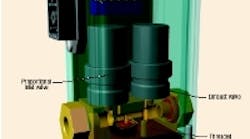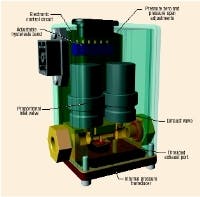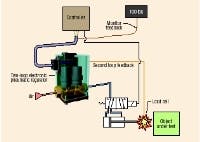Many industries continue to use conventional regulators because of functionality. If a constant pressure is all that is needed, the conventional regulator can simply be set. When a changing or adjustable pressure is required (often based on the dynamics of the application), then an electropneumatic regulator provides significant advantages.
Traditionally, pressure is set by manually adjusting a regulating valve. Turning a knob compresses a spring, which acts against a diaphragm or piston. The air pressure being regulated acts against the other side of the diaphragm or piston to balance against the setting of the spring. A decrease in output pressure unbalances the piston or diaphragm, allowing the spring to force the regulating valve open and increase the air pressure back to equilibrium.
This still works well when one fixed pressure is all that is required, as with a simple pneumatic clamping fixture. Electronically controlled air pressure regulators work differently than manually operated regulators. An electronic regulator provides a controlled output pressure that is proportional to a steady or variable electronic signal. This offers the advantage of changing the pressure remotely, on the fly, as dictated by the dynamics of the application, or in response to other electronic inputs or sensors.
Note: Do not confuse response time with the time required to achieve system pressure. An electronic regulator may respond to a change in command and deliver the requested output pressure in less than 200 ms (response time), but how long it takes for the system to achieve that pressure depends on the tubing size and system volume. With two identical regulators, one may take less than a second to fill a 1-in. bore cylinder, while the other takes almost a minute to fill a tractor tire, even though both have the same response time.
The first pressure regulators
The first electropneumatic regulators consisted of a traditional manual regulator with an electric motor adapted to provide the turning motion-to the knob. These motorized regulators have mostly fallen out of favor, as they are costly and slow to respond. Response time for motorized regulators is 20 to 360 sec, depending on the power consumption, pressure range, and gear ratio selected.
Because motorized regulators do not require electrical power except when changing pressure, they are ideal for failsafe conditions or for installations with limited power, such as a solar-powered installation. In general terms, they are two to three times more expensive than the lowest cost two-wire I/P.
Flapper nozzles
A flapper nozzle or voice coil works by controlling the amount of air bled through an orifice into or out of an air-piloted pressure regulator. This bleed rate is varied to control the pilot pressure by moving a plunger into or out of an orifice. The plunger position is controlled through the force generated by the electronic signal to the coil or piezo element.
This design is also sometimes referred to as a two wire I/P transducer. The units run on a simple two wire loop current loop, and I/P refers to current (I) to pressure (P).
This design uses minimal power and can be driven directly from a typical electronic command signal, such as 4 to 20 mA dc. Low power also means many of these devices carry intrinsically safe ratings.
Low power operation comes with a price, as the small forces created often leave these devices susceptible to vibration or subtle changes in mounting position. Low power also limits the maximum operation pressures. Because these devices evolved around low power control signals using only two-wire loops, signals typically are too weak to provide a feedback to monitor the device or its pressure output.
Flapper nozzles are quick response devices, and can achieve output pressure in less than 200 msec. The flapper nozzle/voice coil design remains popular. Applications today capitalize on the inexpensive two wire control signal and on the high resolution inherent in this fully analog design.
One common application controls the pressure to a pneumatic cylinder, which actuates a damper in a large HVAC system. The electropneumatic regulator is easily controlled from a long distance by the low power control signal from a temperature controller.
Another common application for flapper nozzle electropneumatic regulators is in controlling web tension in an unwinding application. An ultrasonic sensor is used to provide a signal proportional to the roll diameter. This signal is converted by the electropneumatic regulator to a proportional pressure signal. The pressure drives a pneumatically operated brake, keeping unwind web tension the same as the roll diameter decreases.
Two valves and a sensor
The two-valves-and-sensor technology has become popular over the last decade. The principal of operation is simple. Usually two normally closed, two-way solenoid valves are arranged so energizing one allows compressed air to flow into the system; energizing the other allows system pressure to vent to atmosphere. The decision on which valve to energize is made by an on-board electronic circuit, which compares the electronic command signal to an integrally mounted pressure sensor that measures the system pressure. The integral pressure sensor ensures that pressure is controlled accurately and is available as a signal that can be monitored remotely. Careful selection of solenoid valves allows pressure to be controlled from vacuum to 1,000 psig.
The two-valves-and-sensor design, because of its versatile electronic makeup, offers flexibility in many applications, including those requiring pressure control of a higher flow than the solenoid valves can offer by themselves. When the output pressure (work) port of the unit is pneumatically connected to the pilot port of an air-piloted (slave) regulator, high flow rates are possible. If the two-valves-and-sensor unit is used only to control pressure to the dome of a slave regulator, the mechanical design of the slave device will dictate the accuracy, hysteresis, repeatability, and resolution in the system.
This type of regulator is controlled by an onboard circuit, so it can accept an electronic signal from a sensor mounted downstream of the slave device. This downstream sensor becomes the main control in this closed-loop assembly configuration, allowing the pilot to automatically adjust pressure to achieve full scale accuracy specifications of less than 0.2%, repeatability of less than 0.02%, and virtually no hysteresis at high flow rates.
The electronic nature of the two-valves-and-sensor type device allows for direct interface with other types of sensors downstream, to allow for direct pneumatic control of torque, temperature, force, position, and speed.
One application that illustrates this interface with outside sensors is the locally closed-loop force control shown in Figure 2. The electropneumatic regulator provides pressure to a double-acting pneumatic cylinder. The force supplied by the rod of the cylinder is directly measured by a load cell. The load cell's electronic output is measured directly by the electronic regulator, which adjusts the air pressure supplied to the cylinder. By directly comparing the desired setpoint to the actual force measured at the load cell, precise, repeatable force is achieved. This circuit is bi-directional, and can control tension or compression.
Proportional valves
Developments in proportional valve technology — including reductions in cost and power consumption— have led to the most recent advancement in electropneumatic pressure regulators. By adapting the electronic circuit and replacing a traditional on/off solenoid valve in the two-valves-and-sensor configuration with a true proportional valve, the next generation of pressure control is now available.
In a positive pressure application, the proportional valve is mounted in the inlet position and operates proportionally to the voltage supplied to the circuit. This variable orifice effect provides precise control of pressure in flow conditions and eliminates the digital steps of on/off solenoid valves. The exhaust valve remains a standard two-way valve that allows excess air to be vented when required. In an application where precise vacuum control is required, the proportional valve is mounted in the exhaust valve position and the pneumatic connections are adjusted accordingly.
Introducing a proportional valve into this type of control scheme allows the user to benefit from the advantages of the two-valves-and-sensor design, while greatly increasing the resolution and virtually eliminating hysteresis. This type of unit is extremely effective when used in leak testing, in systems with leaks downstream, and in critical applications where even minute pressure fluctuations can be detrimental.
As with the two-valves-and-sensor design, this proportional pressure control design incorporates an internal pressure transducer to measure the controlled pressure output and provide a feedback signal to the electronic circuit. These units provide an analog output, which can be displayed on a meter or sent to a controller for data acquisition or quality assurance.
Similar to the two-valves-and-sensor device, proportional pressure control technology can be provided in a dual-loop version, allowing the introduction of another sensor downstream. The second loop sensor can monitor torque, position, or flow. With recent advancements in mass flow sensors (and reduced costs), coupling them with an appropriately sized proportional control valve can offer accurate, cost effective control of both pressure and flow.
Frictionless pneumatic cylinders offer interesting potential when coupled with this technology. With negligible friction, the pressure supplied to the cylinder can be used to calculate force directly. A proportional valve electropneumatic regulator automatically and smoothly compensates for leakage in the cylinder. The onboard pressure sensor provides a signal proportional to the resulting output force.
Selecting the correct technology for a system includes reviewing the media being controlled, available command signal and power supply, flow rates necessary for the application, pressure ranges, types of rating for the specific environment, and accuracy of control required.
When considering electropneumatic pressure regulators, the entire control scheme should be evaluated. Many components can be eliminated by proper selection of the correct electropneumatic pressure regulator. This allows for superior control of many different processes and a reduction in cost of the overall system.
Larry Dietrich and Ron Hibbler are application engineers at Proportion-Air Inc., McCordsville, Ind. Contact them at (877) 331-1738 or visit www.proportionair.com
| Type of regulator | Advantages | Disadvantages |
| Motorized |
|
|
| Flapper nozzle |
|
|
| Two-valves-and-sensor |
|
|
| Proportional valve |
|
|



